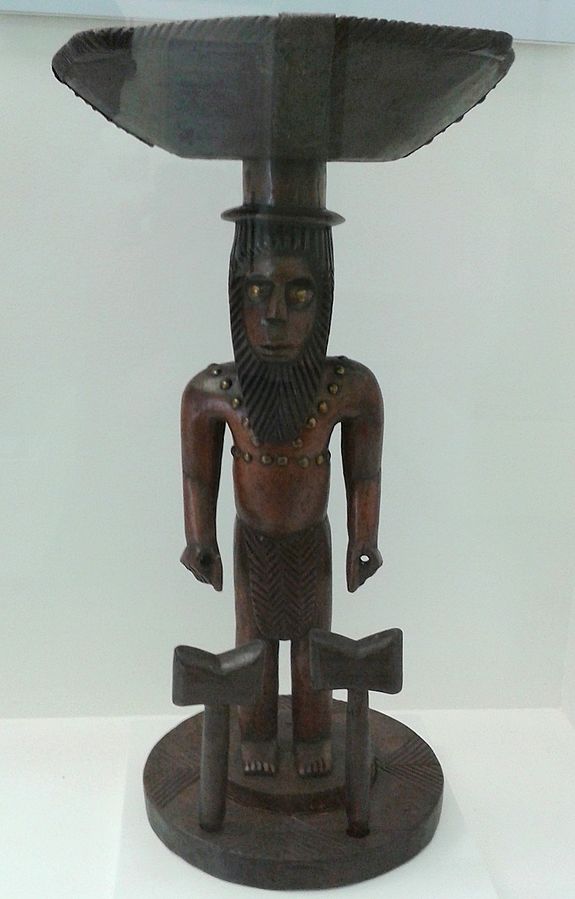Summary | Excerpt | Reading Guide | Reviews | Beyond the Book | Read-Alikes | Genres & Themes | Author Bio

This article relates to Masquerade
 Masquerade by O.O. Sangoyomi repeatedly draws from mythology surrounding the Òrìṣà pantheon of deities from the Yorùbá religion, which is still practiced throughout southern Nigeria, other areas of West Africa, and the African diaspora. Ṣàngó, the bringer of thunder, is particularly highlighted: he is the namesake of capital city Ṣàngótè and a source of political legitimacy as the forefather of the Alàáfin (king). The novel depicts multiple Yorùbáland rituals starring Ṣàngó's storminess — after eating a chickpea during the first feast following her kidnapping by ruler Àrèmo, main character Òdòdó is only allowed to live because she is not subsequently met with Ṣàngó's lightning. This depiction of Ṣàngó is in line with how he represents wrath, fury, and masculinity, all of which are present in the patriarchal powers under the reign of Àrèmo. In another reference to Ṣàngó, Àrèmo's chosen battle weapons are dual double-sided axes; statues of Ṣàngó typically contain an oshe, a double-headed battle-ax, emerging from his head to signify his propensity for war and slaying his enemies.
Masquerade by O.O. Sangoyomi repeatedly draws from mythology surrounding the Òrìṣà pantheon of deities from the Yorùbá religion, which is still practiced throughout southern Nigeria, other areas of West Africa, and the African diaspora. Ṣàngó, the bringer of thunder, is particularly highlighted: he is the namesake of capital city Ṣàngótè and a source of political legitimacy as the forefather of the Alàáfin (king). The novel depicts multiple Yorùbáland rituals starring Ṣàngó's storminess — after eating a chickpea during the first feast following her kidnapping by ruler Àrèmo, main character Òdòdó is only allowed to live because she is not subsequently met with Ṣàngó's lightning. This depiction of Ṣàngó is in line with how he represents wrath, fury, and masculinity, all of which are present in the patriarchal powers under the reign of Àrèmo. In another reference to Ṣàngó, Àrèmo's chosen battle weapons are dual double-sided axes; statues of Ṣàngó typically contain an oshe, a double-headed battle-ax, emerging from his head to signify his propensity for war and slaying his enemies.
According to Yorùbá oral tradition, Ṣàngó was originally a human king: the fourth (or third, in some renditions) of the Oyo Empire. In keeping with his later personification of the natural forces of storms, the human Ṣàngó purportedly had a voice like thunder and a mouth that spewed fire in speech. Despite these powers, a subordinate chief dared to challenge his rule through feats of magic. When the majority of Ṣàngó's subjects deserted him for the subordinate chief, Ṣàngó left Oyo to kill himself. But his followers believed that his death was actually a heavenly transformation into an Òrìṣà. The story of Ṣàngó appropriated several facets of Jakuta, a preexisting deity.
Another version of the story of Ṣàngó's death follows his discovery of a charm that supposedly could call lightning down from the heavens. When trying this charm on a hill, he succeeded in calling down a storm but also unintentionally brought lightning onto his palace. As a result, most of his family was killed, and a broken Ṣàngó hanged himself on an ayan tree (the wood of which was used to make axes).
Ṣàngó is depicted as having three wives: Oya, the goddess of the Niger River, who like Ṣàngó is associated with storms, as well as destruction and transformation; Oba, the goddess of the Oba River; and Òsun, the goddess of the Oshugbo River, associated with love and fertility. Oba was Ṣàngó's first wife, Òsun the second, and Oya, whom he crowned as queen, the third. Ṣàngó's favorite was Òsun because of her delicious cooking. According to a version of one story, when Oba asked for the secret behind her cooking, Òsun, out of jealousy, lied and claimed that she always cut off a part of her ear to put in Ṣàngó's meals. Following these false instructions, Oba prepared Ṣàngó's favorite dish with the inclusion of a slice of her ear. But when Ṣàngó saw the ear in his food, he became enraged. Believing this to be a poisoning attempt, he banished Oba from his house. As she ran out crying, she fell to the ground and transformed into a river. When Ṣàngó later discovered Òsun's deception, he called her out into the rain in anger, where she, in turn, became a waterfall.
Representation of Ṣàngó.
Collection of African and Afro-Brazilian ethnography of the National Museum of Brazil, Rio de Janeiro.
Photo by Dornicke (CC BY-SA 4.0)
Filed under Places, Cultures & Identities
![]() This article relates to Masquerade.
It first ran in the July 31, 2024
issue of BookBrowse Recommends.
This article relates to Masquerade.
It first ran in the July 31, 2024
issue of BookBrowse Recommends.
Your guide toexceptional books
BookBrowse seeks out and recommends the best in contemporary fiction and nonfiction—books that not only engage and entertain but also deepen our understanding of ourselves and the world around us.